Overview
- Motivation
- The SINS/zC-SINF survey and synergies with HST and LBT/LUCI surveys
- Galaxy kinematics and structure at high redshift
- Properties and evolution of high redshift disks
- Vigorous feedback from star formation and AGN
- Nebular gas excitation and metallicity
- Taking the next step with the KMOS3D survey
THE MOTIVATION
The z ~ 2 Universe, at look-back times of ~10 billion years, is now known to represent a critical epoch in the mass assembly of galaxies. During this era, both the cosmic star formation rate and the luminous quasar space density are at their peak. The assembly of galaxies is correspondingly rapid, with the total stellar mass density in galaxies increasing from ~15% to ~50-75% its current value between z ~ 3 and z ~ 1. The multitude of multi-wavelength photometric surveys and large optical spectroscopic campaigns carried out over the past decade have set the stage for detailed spatially-resolved studies of individual galaxies. Such studies are essential to pin down the actual processes that drive early galaxy evolution and to address key questions such as: What is the relative importance of mergers versus smooth infall in the accretion of mass? What is the connection between bulge and disk formation? What is the interplay between angular momentum, dissipation, and feedback processes? Is the star formation at high redshift mostly driven by major mergers between galaxies of comparable mass, as in present-day galaxies with similarly high star formation rates?
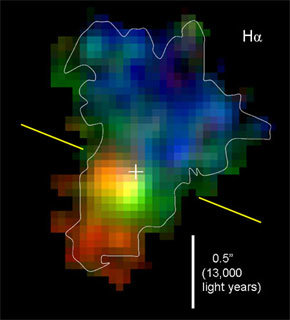
Detailed information on the dynamics, morphologies, and physical properties of distant massive star-forming galaxies at lookback times of 8–12 billion years (cosmological redshifts z ~ 1–4), when a major fraction of the mass in stars seen in present-day galaxies is believed to have been put in place. Observations at near-infrared (1–2.5 μm) wavelengths are well-suited to study galaxies at z ~ 1–4 because many key diagnostic spectral features in the rest-frame optical spectrum of galaxies are redshifted in the near-infrared bands. This includes important emission lines from ionized gas tracing the sites of intense star-formation activity or shock-excited material (such as the hydrogen Balmer recombination lines of Hα and Hβ, and the forbidden lines from atomic fine-structure transitions of [NII], [OIII], [OII], [SII]). At rest-optical wavelengths, the continuum light traces more closely the stars that dominate the stellar mass, as it is less affected by dust obscuration and outshining by young luminous stars. Until only a few years ago, spatially- and spectrally-resolved information of such key spectral diagnostics were virtually non-existent. This has now changed, notably with the advent of sensitive near-IR integral field spectrographs mounted on 8–10 m ground-based telescopes, such as SINFONI at the ESO Very Large Telescope.
THE SINS/zC-SINF SURVEY WITH SINFONI AND SYNERGIES WITH HST AND LBT/LUCI SURVEYS
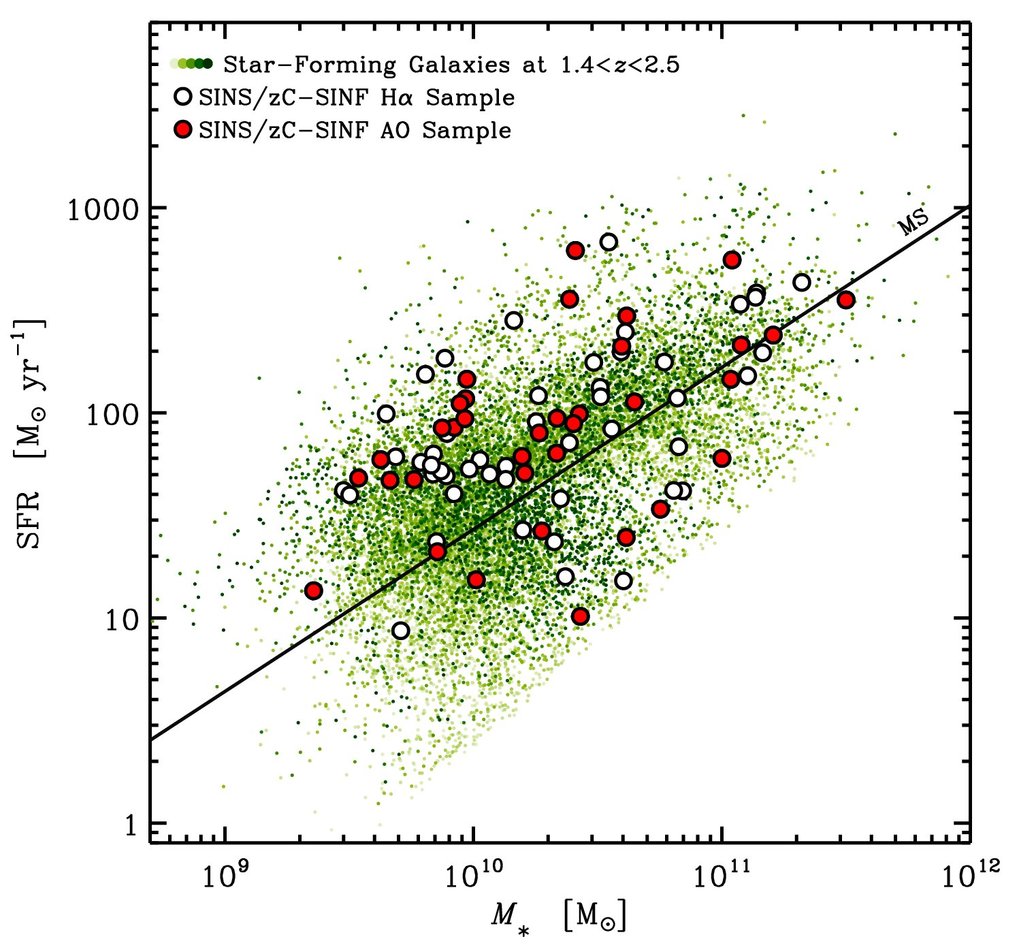
"SINS/zC-SINF" is the first and largest survey of spatially-resolved ionized gas kinematics, star formation, and physical properties at z ~ 2, carried out with the near-IR integral field spectrometer SINFONI at the VLT. The survey was initiated as a major part of the MPE IR/Submm group Guaranteed Time Observations (GTO) for SPIFFI and PARSEC (the MPE-built spectrometer of SINFONI and the laser for the VLT Laser Guide Star Facility) and expanded through an ESO Large Program in collaboration with the zCOSMOS team. Over 100 nights were devoted for observations of 110 z ~ 1 – 3 galaxies, focussing on Hα and [NII] emission, in seeing-limited mode for all objects (4 – 5 kpc resolution) and with adaptive optics (AO) for a sharper view of 35 of the targets (1 – 2 kpc resolution). SINS/zC-SINF probes the bulk of the z ~ 2 star-forming galaxy (SFG) population over two orders of magnitude in stellar mass and star formation rate (right figure, M∗ ~ 3 × 109 – 3 × 10sup>9 Msun, SFR ~ 10 &ndash 800 Msun/yr; Förster Schreiber et al. 2009, 2013; Mancini et al. 2011). The deep SINFONI+AO data were complemented with sensitive ~ 1.5 kpc resolution mapping of the stellar component using HST NICMOS and WFC3 near-IR imaging. In parallel, our detailed studies of galaxy morphologies from HST ACS optical and WFC3 near-IR imaging in the CANDELS survey fields and our emission line survey of another 100 z ~ 2 galaxies with the multi-object spectroscopic mode of LUCI (built in part by MPE) at the Large Binocular Telescope (LBT) have provided concurring evidence strengthening several of our main SINFONI results.
GALAXY KINEMATICS AND STRUCTURE AT HIGH REDSHIFT
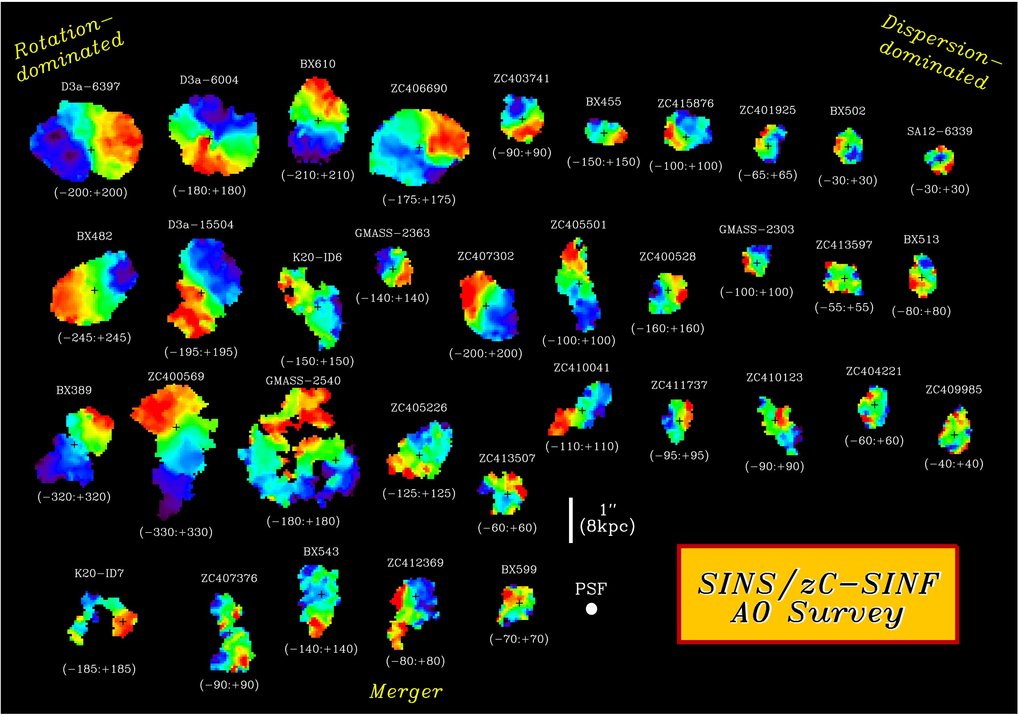
Our SINS/zC-SINF survey of the ionized gas kinematics traced by the Hα emission revealed that over half
of the galaxies are regularly rotating disks, and a minority consists of interacting/merging systems and more
compact, velocity dispersion-dominated objects (Shapiro et al. 2008; Förster Schreiber et al. 2009;
Mancini et al. 2011; Newman et al. 2013).
This is illustrated by the overview of the Hα velocity fields obtained at ~ 1.5 kpc resolution for the 35
galaxies observed with SINFONI and AO (left figure).
The rotation velocity vrot scales roughly linearly with galaxy size,
consistent with centrifugally-supported baryonic disks of constant angular momentum parameter within virialized
dark matter halos.
The rest-optical light and stellar mass maps of the SINS/zC-SINF AO galaxies also shows a majority of disk-like
profiles and reveals the presence of a bulge-like component in the most massive galaxies
(Förster Schreiber et al. 2011a; Lang et al., in prep.).
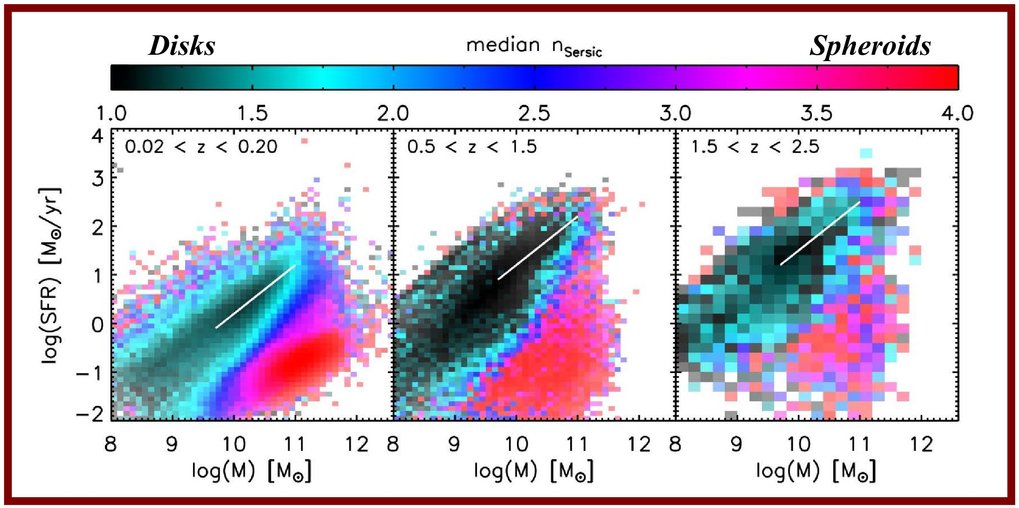 The prevalence of disks among distant SFGs is further strengthened by our study of rest-UV/optical
morphologies of large mass-selected samples out to z ~ 2.5: the tight locus defined by the
vast majority of SFGs in M∗ versus SFR is dominated by disk-like
systems while rarer "outliers" above and below this "main sequence" show more
compact, cuspier morphologies (right figure, from Wuyts et al. 2011).
This result showed most convincingly that a correlation between galaxy structure and stellar populations,
i.e. a Hubble sequence, was already in place just about 3 Gyr after the Big Bang. Our resolved measurements
of the kinematics and structure of high redshift galaxies provided key evidence that smoother accretion and
internal dynamical processes play a dominant role in growing galaxies, rather than violent major mergers that
had been favored for some time. Theoretical support for these findings was provided by our analysis of
halo merger fractions and mass accretion rates based on the Millenium Simulation (Genel et al. 2008).
The prevalence of disks among distant SFGs is further strengthened by our study of rest-UV/optical
morphologies of large mass-selected samples out to z ~ 2.5: the tight locus defined by the
vast majority of SFGs in M∗ versus SFR is dominated by disk-like
systems while rarer "outliers" above and below this "main sequence" show more
compact, cuspier morphologies (right figure, from Wuyts et al. 2011).
This result showed most convincingly that a correlation between galaxy structure and stellar populations,
i.e. a Hubble sequence, was already in place just about 3 Gyr after the Big Bang. Our resolved measurements
of the kinematics and structure of high redshift galaxies provided key evidence that smoother accretion and
internal dynamical processes play a dominant role in growing galaxies, rather than violent major mergers that
had been favored for some time. Theoretical support for these findings was provided by our analysis of
halo merger fractions and mass accretion rates based on the Millenium Simulation (Genel et al. 2008).
PROPERTIES AND EVOLUTION OF HIGH REDSHIFT DISKS
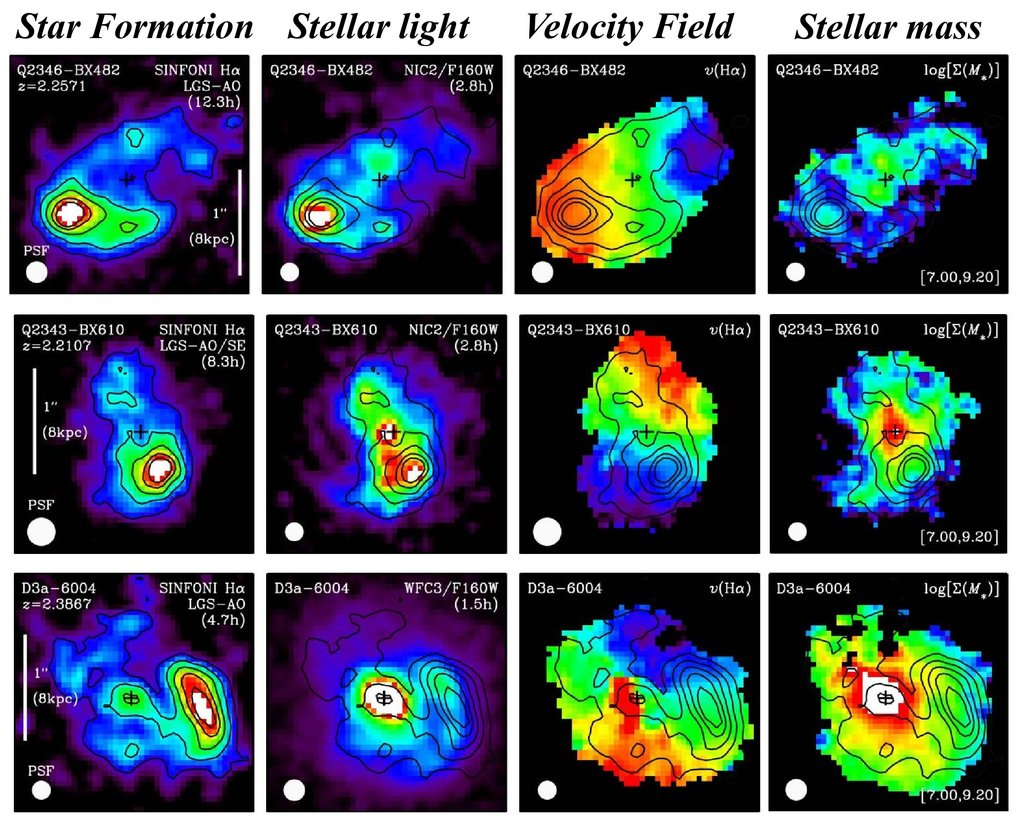
Remarkably, we found that z ~ 2 disks are characterized by high intrinsic velocity dispersions of σ0 ~ 30 – 80 km/s and inferred gas-to-baryonic mass fractions of ~ 50% (Genzel et al. 2006, 2008; Förster Schreiber et al. 2006, 2009; Cresci et al. 2009; Newman et al. 2013). The velocity dispersions are 5 – 10 times higher than in present-day disks, implying that young disk galaxies are dynamically hotter and geometrically thicker, plausibly as a consequence of the enhanced accretion and star formation rates at early cosmic epochs. In contrast to the rotation velocity vrot, the intrinsic dispersion σ0 shows little if any dependence on galaxy size, explaining the larger fraction of dispersion-dominated (vrot / σ0 < 1) objects among smaller galaxies. The z ~ 2 disks often exhibit luminous kpc-sized clumps in Hα and rest-UV/optical light, each clump contributing typically a few percents and up to ~ 20% of the galaxies' SFRs and luminosities (Genzel et al. 2008, 2011; Förster Schreiber et al. 2011b; Wuyts et al. 2012). In pilot studies of a subset of galaxies, we found trends of increasing central dynamical mass fraction with galaxy evolutionary stage, and of older clump ages at smaller galactocentric radii (Genzel et al. 2008; Förster Schreiber et al. 2011b). These trends are consistent with theoretical arguments and numerical simulations of turbulent gas-rich disks in which giant star-forming clumps result from violent gravitational instabilities and bulges form via efficient secular processes on timescales < 1 Gyr. Inward clump migration could be an important path for bulge formation if clumps survive to strong stellar feedback and tidal torques.
VIGOROUS FEEDBACK FROM STAR FORMATION AND AGN
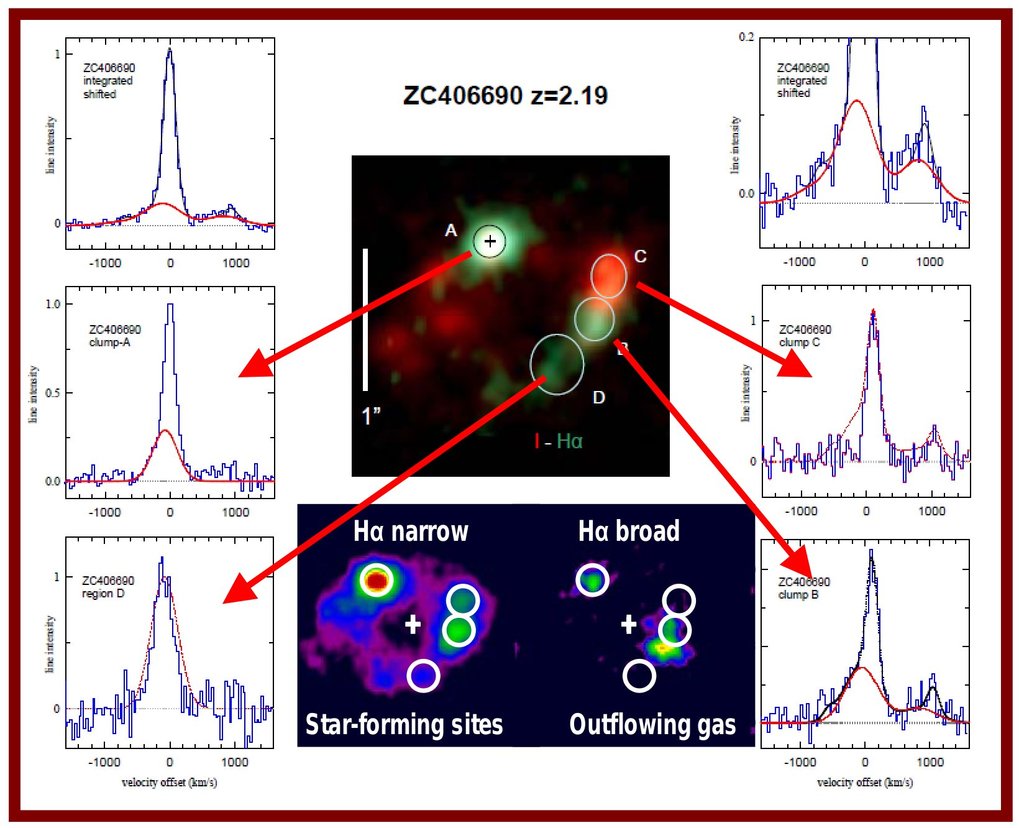
Our SINS/zC-SINF survey uncovered strong, spatially-extended ionized gas outflows revealed by a broad
FWHM ~ 450 km/s Hα+[NII] component underneath the narrower emission tracing star formation,
and which, in some of the disks, originates from individual bright clumps (Genzel et al. 2011; Newman et al. 2012a,b).
The figure (left) shows one of the SINS/zC-SINF galaxy where the telltale outflow signature of a broad,
blueshifted emission component is clearly seen in and around bright star-forming clumps.
This discovery pinned down the roots of the ubiquitous galactic-scale winds at high redshift so far only
observed on > 10 kpc scales (e.g., Shapiro et al. 2009).
The winds appear to set at a SFR surface density
of ~ 1 Msun/yr/kpc2,
10 times higher than the break-out threshold in nearby starbursts and attributed to enhanced gas pressure
in z ~ 2 disks.
Outflow rates from clumps and from the galaxies reach up to several times their SFRs — the first
empirical constraint at z > 1 on mass loading, a key parameter in theoretical models of star
formation-driven feedback. Gas-rich clumps may be self-destroyed by the vigorous feedback before they
migrate to the galaxy center, as seen in our numerical simulations (Genel et al. 2012).
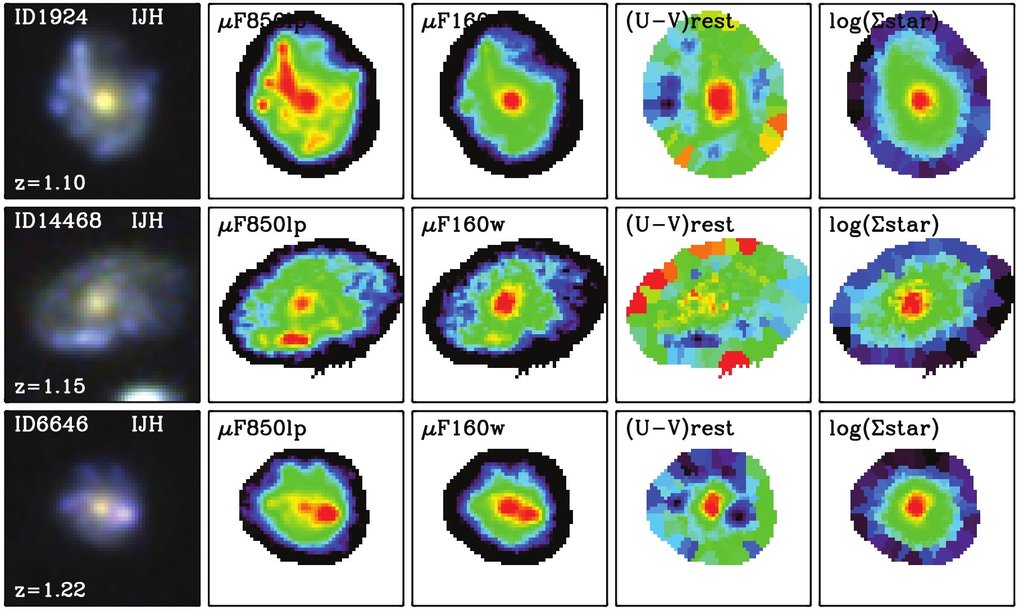 Our HST studies showed that massive z ~ 0.5 – 2.5 star-forming galaxies appear smoother
in stellar mass than in rest-UV/optical light; clumps thus trace local peaks in star formation rather than
in mass, and their typical stellar properties are consistent with rapid in-situ disruption unless they are
able to migrate inward within ~ 1 orbital timescale (Wuyts et al. 2012). These findings set tight constraints
on theoretical scenarios of early bulge and disk growth.
Our SINFONI data further uncovered strong nuclear outflows in all of the most massive galaxies
(M∗ > 1011 Msun),
all of which are large disks with evidence for a significant stellar bulge.
The broad nuclear component has enhanced [NII]/Hα > 0.5 and FWHM ~ 1000 – 1500 km/s,
highly suggestive of outflows driven by an AGN. The average wind densities and mass loading factors are
comparable to those of the star formation-driven outflows. The frequency of these AGN-driven outflows
at the high-mass end suggests they have a large duty cycle and may thus contribute significantly to the
rapid quenching of star formation activity observed at galaxy masses above
~ 1011 Msun.
Our HST studies showed that massive z ~ 0.5 – 2.5 star-forming galaxies appear smoother
in stellar mass than in rest-UV/optical light; clumps thus trace local peaks in star formation rather than
in mass, and their typical stellar properties are consistent with rapid in-situ disruption unless they are
able to migrate inward within ~ 1 orbital timescale (Wuyts et al. 2012). These findings set tight constraints
on theoretical scenarios of early bulge and disk growth.
Our SINFONI data further uncovered strong nuclear outflows in all of the most massive galaxies
(M∗ > 1011 Msun),
all of which are large disks with evidence for a significant stellar bulge.
The broad nuclear component has enhanced [NII]/Hα > 0.5 and FWHM ~ 1000 – 1500 km/s,
highly suggestive of outflows driven by an AGN. The average wind densities and mass loading factors are
comparable to those of the star formation-driven outflows. The frequency of these AGN-driven outflows
at the high-mass end suggests they have a large duty cycle and may thus contribute significantly to the
rapid quenching of star formation activity observed at galaxy masses above
~ 1011 Msun.
NEBULAR GAS EXCITATION AND METALLICITY
Analysis of Hα, [NII], [OIII], and Hβ line emission among our SINFONI+LUCI samples confirms enhanced global nebular excitation at z ~ 2 compared to typical z ~ 0 SFGs, implying higher ionization parameters and electron densities in the non-AGN galaxies (Newman et al. 2013b). Shock excitation attributed to star formation-driven outflows is detected around bright clumps in our best-case, high S/N non-AGN disk (Newman et al. 2012a). The LUCI+SINS/zC-SINF galaxies follow the previously reported z ~ 2 mass-metallicity (M—Z) relation but suggest higher metallicities and/or more frequent AGN contamination at the high-mass end, partly reflecting the lesser bias against dustier and/or more evolved galaxies in our samples (Kurk et al. 2013). At fixed stellar mass, galaxies with higher SFRs do not tend to be more metal-poor, challenging a recently proposed fundamental M∗–Z–SFR relation. In general, negative metallicity gradients are inferred from the SINFONI+AO [NII]/Hα radial profiles (Förster Schreiber et al. 2013). The gradients are overall shallower than those of present-day spiral galaxies, consistent with beam-smearing effects at z ~ 2 and the fact that our SINS/zC-SINF galaxies likely evolve into more massive, earlier-type galaxies by z ~ 0.
TAKING THE NEXT STEP WITH KMOS3D
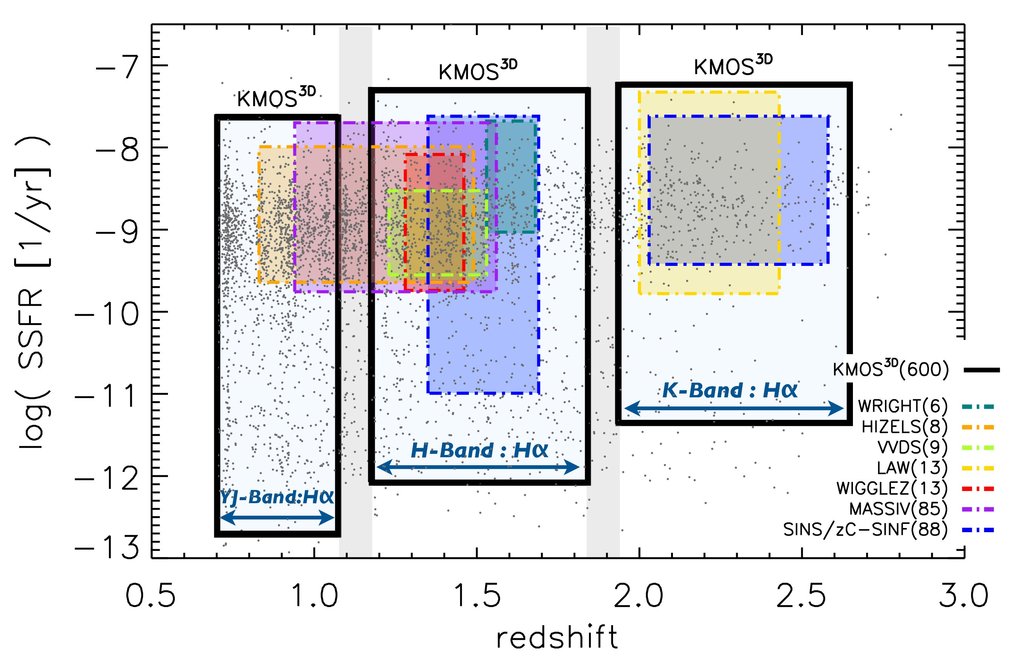
It is now essential to expand our studies larger, homogeneous, and more complete samples.
We are undertaking KMOS3D,
a comprehensive multi-year survey of Hα+[NII]+[SII] emission leveraging the 24× multiplexing
capabilities of the new
KMOS
multi-object near-IR integral field spectrograph at the ESO VLT to study
spatially-resolved kinematics, star formation, outflows, nebular excitation, and metallicities of
~ 600 z = 0.7 – 2.6 mass-selected galaxies. This survey is a joint venture of the MPE
IR/Submm and OPINAS
groups, dedicating ~ 70 nights of Guaranteed Time for building KMOS (a Germany/UK project).
KMOS3D capitalizes on the
3D-HST
and CANDELS HST Treasury Surveys,
providing unique multi-wavelength data and large mass-limited samples with accurate redshifts.
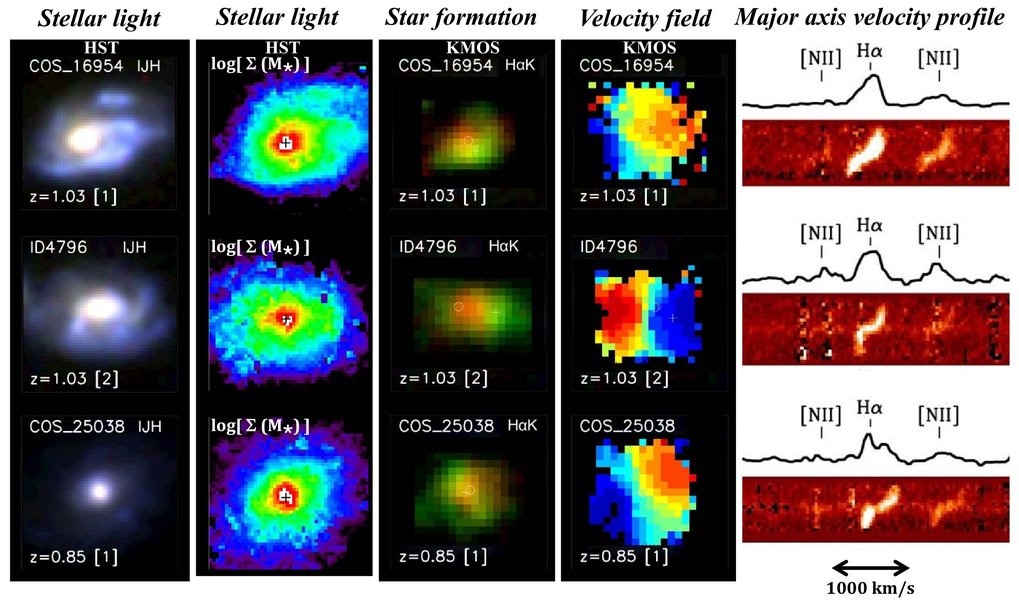 The
survey will enable us for the first time to establish firmly the connection between galaxy kinematics and
stellar structure, to determine the role of star formation and AGN in governing stellar mass growth, to
test systematically the imprint of feedback on galaxy formation efficiency, and to explore the influence of
environment. Early KMOS observations show the potential of this approach — stellar light, mass,
star formation, and kinematics of three striking spiral-like galaxies with a bulge and steep inner velocity
gradients revealing a high central mass concetration are shown on the left.
KMOS3D will offer an unbiased view in unprecedented
detail of galaxy evolution across the peak of cosmic SFR, tracing key transformations at the origin of today's
Hubble sequence.
The
survey will enable us for the first time to establish firmly the connection between galaxy kinematics and
stellar structure, to determine the role of star formation and AGN in governing stellar mass growth, to
test systematically the imprint of feedback on galaxy formation efficiency, and to explore the influence of
environment. Early KMOS observations show the potential of this approach — stellar light, mass,
star formation, and kinematics of three striking spiral-like galaxies with a bulge and steep inner velocity
gradients revealing a high central mass concetration are shown on the left.
KMOS3D will offer an unbiased view in unprecedented
detail of galaxy evolution across the peak of cosmic SFR, tracing key transformations at the origin of today's
Hubble sequence.